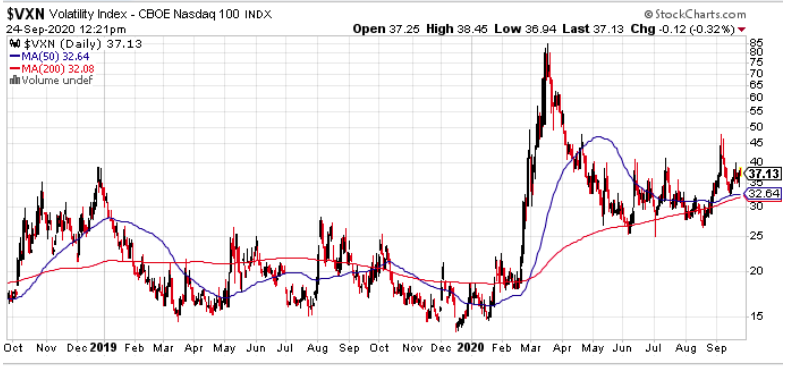
How to Profit in a Volatile Market
By: Steve Smith
Within the first trading hour on Thursday, both the “SPDR S&P 500 (SPY – Get Rating)” and “Nasdaq 100 (QQQ – Get Rating)” dropped 1.1%, rallied 2%, then declined 1.3% before settling around midday while attempting to stabilize, following yesterday’s steep sell-off. This is seemingly the new normal and very “2020” — a year best summed up as: “unprecedented,” presenting unique opportunities for nimble and opportunistic traders. To date this year, there have been 42 days where the SPY and QQQ have moved above 2%; more than quadrupling the average number of 2%+ sessions in the last five years.
In fact, in 2017, there were only eight days that saw moves in excess of just 1% — one of the least volatile years on record. The SPY has now given back most of its year-to-date gains with both it and the QQQ’s still standing in the 10% correction territory. While I think we could see a short-term bounce, I maintain my stance from last week that the selling is not over.
[SPECIAL Sale Extended] Learn about the One-Month $19 Trial Offer Our Market Experts Are Ranting & Raving About —the Options360 Service!
Likewise, I think volatility will remain high well into 2021. My belief rests on several factors. First, it’s looking increasingly likely that the election will be contested without a resolution for weeks after November 3. Second, the coronavirus isn’t disappearing causing most of the world to keep retrenching in terms of reopening the economy. And finally, historical data has shown that volatility is cyclical, and when there’s a significant upswing it can take months or years for it to subside. Think of the crisis which ignited elevated volatility much like a bad ankle sprain, as it takes time for the swelling to subside with any inadvertent bang causing inflammation that will lead to continued caution.

DO NOT Miss Out! Click here and try Options360 for just $19 — Before It’s Too Late
This is all taking place as we head into what’s seasonally the most volatile time of the year. A “Goldman Sachs (GS)” study indicates that in the past 30 years, volatility tends to be 25% higher in October than any other month. And of course, October’s notorious for black swan events, such as the 1987 crash, the 1991 mini-crash, the 1997 Asian contagion currency crisis, and the dot.com bust bottoming of 2002. For astute option traders, this is considered an opportunistic time, which should be embraced. As I always say, find the option strategy that best aligns with your thesis and the market environment. For the Option360 service, this has meant a distinctive shift from debit positions employing credit spreads — both bullish and bearish —to capitalize on the heightened volatility. Whereas in 2017-2019, the Option360 leaned heavily on debit positions. In 2020, nearly half of the trades have been credit spread.
In fact, the last 4 trades this month (bull put spread in “Wal-Mart (WMT)”, bear call spread in “Best Buy (BBY)” an iron condor in “IBM (IBM) and a QQQ bear call have all been profitable. Year to date, Option360 now stands up 32%! This far outpaces the SPY’s 1% gain. As I stated above, I expect volatility to remain elevated and I plan on continuing to take advantage of the plumped up premiums.
[Last Chance] Take Advantage of this Exclusive $19 Trial Offer to the Options 360 Service!
About author
Steve Smith have been involved in all facets of the investment industry in a variety of roles ranging from speculator, educator, manager and advisor. This has taken him from the trading floors of Chicago to hedge funds on Wall Street to the world online. From 1987 to 1996, he served as a market maker at the Chicago Board of Options Exchange (CBOE) and Chicago Board of Trade (CBOT). From 1997 to 2007, he was a Senior Columnist and Managing Editor for TheStreet.com, handling their Option Alert and Short Report newsletters. The Option Alert was awarded the MIN “best business newsletter” in 2006. From 2009 to 2013, Smith was a Senior Columnist and Managing Editor for Minyanville’s OptionSmith newsletter, as well as a Risk Manager Consultant for New Vernon Capital LLC. Smith acted as an advisor to build models and option strategies to reduce portfolio exposure and enhance returns for the four main funds. Since 2015, he has worked for Adam Mesh Trading Group. There, he has managed Options360 and Earning 360, been co-leader of Option Academy, and contributed to The Option Specialist website.
Related Articles
-
-
2 Trades I’m Focusing on Amid this Week’s Volatility
November 10, 2020 -
We Have a Winner?
November 9, 2020 -
Why It’s Time for You to Go ‘Long’
November 7, 2020

Subscribe To OurDaily Newsletter
Join our mailing list to receive the latest news and updates from Option Sensei.
![[Veterans Day Special] I Want to Say, ‘Thank You’…](https://optionsensei.com/wp-content/uploads/2018/10/shutterstock_415926982-120x120.jpg)


